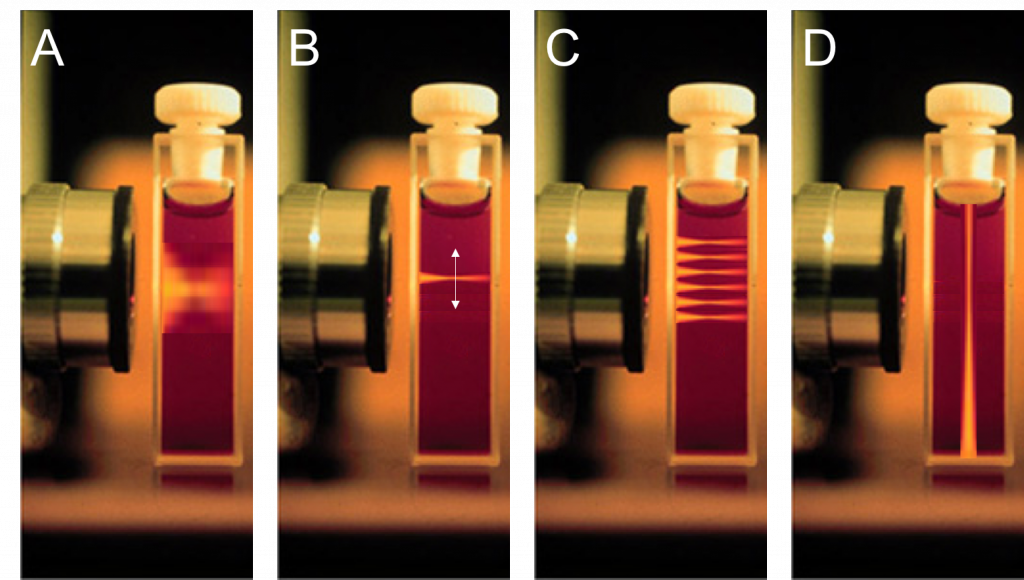Introduction
Conventional fluorescence microscopy involves flooding the whole sample with light and receiving emission light from the focal plane and also out-of-focus areas, resulting in lots of background fluorescence. Signal can be improved but involves using more intense laser light, which often results in phototoxic effects that can damage and eventually kill the sample organism. This combination of poor image quality, lack of reliable 3D imaging and gradual degradation of sample due to intense light means that alternatives to conventional widefield fluorescence microscopy are necessary.
One alternative is confocal microscopy, which uses pinholes to block all out-of-focus light and only detects light from the focal plane (Figure 2A). The use of pinholes results in a higher contrast image with a much better signal to noise ratio. The pinholes also allow for optical sectioning, where images of different 2D focal planes can be built up into a 3D image without having to physically section the sample.
Spinning disk confocal microscopes allow for high speed, high quality 3D images of live biological samples, however, although pinholes stop out-of-focus light from affecting the resulting image, these out-of-focus areas are still exposed to light and emit fluorescence, it just is blocked by a pinhole and not detected, so the sample can still undergo photo-damage.
An ideal alternative fluorescence technique for 3D live cell imaging over long timescales would:
- Minimally photo-damage and bleach live samples so observations can last longer
- Observe fast 3D dynamic processes over long time periods
- Image large, living 3D specimens without having to mount/fix on a coverslip or flat surface
- Freely move the sample in 3D, including rotation
- Avoid out-of-focus fluorescence data in order to reduce out-of-focus light
- Allow for easy optical sectioning
This alternative is light sheet microscopy, popularized in 2004 as Single Plane Illumination Microscopy (SPIM), based upon illumination techniques from as long ago as 1903. The differences between widefield (conventional fluorescence microscopy), confocal and light sheet illumination methods can be seen in Figure 1

Light Sheet Microscopy
In typical microscopy techniques, the illumination and imaging systems use the same light path and are on the same axis. In light sheet microscopy, the illumination beam is perpendicular to the imaging system (Figure 1D, Figure 2), creating a sheet of light through a particular 2D plane of the sample. This imaging plane is the same as the focal plane, and there is little excitation above or below, meaning there is minimal out-of-focus light.
By using a lens shaped like a cylinder, excitation light is shaped into an hourglass as the light is compressed in one dimension but not the other, as seen in Figure 2D. This shape allows for a sample to be located in the thin ‘waist’ of the beam (where the sheet is focused) where only a small plane of the sample is excited. The emitted fluorescence is detected up by a different objective which leads to the camera, as seen in Figure 2B.
This imaging setup has multiple benefits. Firstly, a single 2D plane of the sample can be imaged quickly, meaning fast dynamic processes can be seen. Secondly, only one plane is being excited, meaning that there is far less out-of-focus light (when compared to widefield and confocal), which improves signal. A comparison of the light paths in confocal and light sheet can be seen in Figure 2.

Images adapted from Kromm et al. (2016).
In many light sheet systems the optics are static and won’t move, meaning that the sample needs to be moved if the image needs to be adjusted. This means the sample is prepared on a moveable stage which can move in the three main dimensions x, y and z, as well as rotational movement. Movement in xyz allows the light sheet to scan across a large sample, with the images stitched together digitally to create an image larger than the field of view of the camera. Rotational movement allows viewing of the sample from multiple angles and a 3D image can be produced, which is higher quality due to multiple angle images being fused together.
Scanning over samples in xyz/rotation in light sheet microscopy allows for a high quality composite image to be built within seconds to minutes, as opposed to minutes to hours when using a confocal microscope. In addition, even when moving the sample through the light sheet the exposure and photo-damage is reduced significantly, which allows for imaging live for much longer and obtaining more relevant data.
Light Sheet Implementations
There are many different types of light sheet fluorescence microscope (LSFM), mostly based on the original single plane illumination microscopy (SPIM) design. While SPIM was the original technique, it has been heavily built on over the years, resulting in many configurations of SPIM for use with specific applications.
Light sheet microscopy is a very active area of development and new configurations are created all the time. The list of SPIM acronyms seemingly gets longer every day but some are more well known than others – popular configurations include L-SPIM, T-SPIM, diSPIM and mSPIM. There are also multiple different commercially available systems.
References
Huisken J, Swoger J et al. (2004) Optical sectioning deep inside live embryos by selective plane illumination microscopy. Science. Aug 13;305(5686):1007-9
Kromm D, Thumberger T, Wittbrodt J. (2016) An eye on light-sheet microscopy. Methods Cell Bio. 133, 105-23
